
The Polo Grounds was the name of three stadiums in Upper Manhattan, New York City, used mainly for professional baseball and American football from 1880 through 1963. The original Polo Grounds, opened in 1876 and demolished in 1889, was built for the sport of polo. Bound on the south and north by 110th and 112th streets and on the east and west by Fifth and Sixth (Lenox) avenues, just north of Central Park, it was converted to a baseball stadium when leased by the New York Metropolitans in 1880.

Griffith Stadium stood in Washington, D.C., from 1911 to 1965, between Georgia Avenue and 5th Street, and between W Street and Florida Avenue NW.

National League Park during most of its history, and commonly referred to as Baker Bowl since 1923, was a baseball stadium and home to the Philadelphia Phillies from 1887 until 1938, and first home field of the Philadelphia Eagles from 1933 to 1935. The ballpark was located in North Philadelphia on a city block bounded by N Broad St, W Huntingdon St, N 15th St, and W Lehigh Ave.
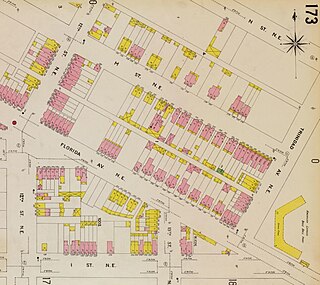
American League Park, known by historians as American League Park I, was a baseball park that formerly stood in the Trinidad neighborhood of Washington, D.C., at the corner of Florida Avenue and Trinidad Avenue NE on land previously belonging to the Washington Brick Company. It hosted the Washington Senators from the 1901 season through the 1903 season.

Columbia Park or Columbia Avenue Grounds was a baseball park in Philadelphia. It was built in 1901 as the first home of the Philadelphia Athletics, who played there for eight seasons, including two games of the 1905 World Series.
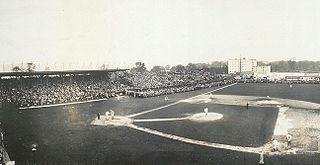
Hilltop Park was the nickname of a baseball park that stood in the Washington Heights neighborhood of New York City. It was the home of the New York Yankees of Major League Baseball from 1903 to 1912, when they were known as the "Highlanders". It was also the temporary home of the New York Giants during a two-month period in 1911 while the Polo Grounds was being rebuilt after a fire.
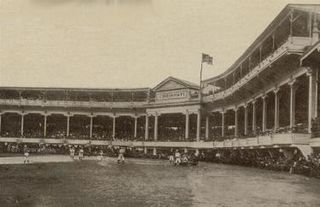
Palace of the Fans was a Major League baseball park located in Cincinnati, Ohio. It was the home of the Cincinnati Reds from 1902 through 1911. The ballpark was on an asymmetrical block bounded by Findlay Street (south), Western Avenue, York Street (north) and McLean Avenue (west).

Robison Field is the best-known of several names given to a former Major League Baseball park in St. Louis, Missouri. It was the home of the St. Louis Cardinals of the National League from April 27, 1893 until June 6, 1920.
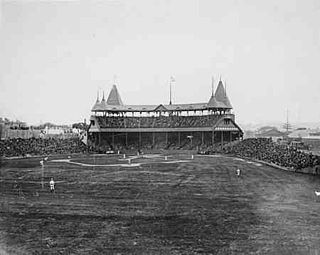
South End Grounds refers to any one of three baseball parks on one site in Boston, Massachusetts. They were home to the franchise that eventually became known as the Boston Braves, first in the National Association and later in the National League, from 1871 to 1914.
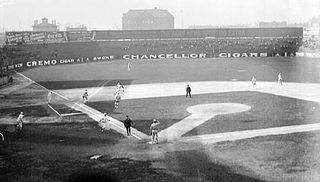
South Side Park was the name used for three different baseball parks that formerly stood in Chicago, Illinois, at different times, and whose sites were all just a few blocks away from each other.
Washington Park was the name given to three Major League Baseball parks on two different sites in the Park Slope neighborhood of Brooklyn, New York, located at Third Street and Fourth Avenue. The two sites were diagonally opposite each other at that intersection.
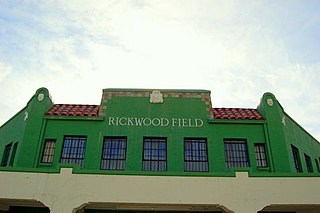
Rickwood Field, located in Birmingham, Alabama, is the oldest professional baseball park in the United States. It was built for the Birmingham Barons in 1910 by industrialist and team-owner Rick Woodward and has served as the home park for the Birmingham Barons and the Birmingham Black Barons of the Negro leagues. Though the Barons moved their home games to the Hoover Met in the suburbs, and most recently to Regions Field in Birmingham, Rickwood Field has been preserved and is undergoing gradual restoration as a "working museum" where baseball's history can be experienced. The Barons also play one regular season game a year at Rickwood Field. Rickwood Field is listed on the National Register of Historic Places.

West Side Park was the name used for two different baseball parks that formerly stood in Chicago, Illinois. They were both home fields of the team now known as the Chicago Cubs of the National League. Both parks hosted baseball championships. The latter of the two parks, where the franchise played for nearly a quarter century, was the home of the first two world champion Cubs teams, the team that posted the best winning percentage in Major League Baseball history and won the most games in National League history (1906), the only cross-town World Series in Chicago (1906), and the immortalized Tinker to Evers to Chance double-play combo. Both ballparks were what are now called "wooden" ballparks.

The Jackie Robinson Ballpark is a historic baseball field in Daytona Beach, Florida, United States. It is located at 105 East Orange Avenue on City Island, in the Halifax River.

Recreation Park was a baseball park in Philadelphia.

Avista Stadium is a baseball park in the northwest United States, located in Spokane Valley, Washington. It is the home ballpark of the Spokane Indians, a minor league baseball team in the High-A Northwest League.

Vaughn Street Park was a baseball park in the northwest United States, located in Portland, Oregon. Opened in 1901, it lasted for over a half century and was torn down in 1956. Its primary tenant was the Portland Beavers of the Pacific Coast League (PCL). During a stretch when the club was tagged as the "Lucky Beavers", the ballpark was also sometimes called Lucky Beavers Stadium.

Clearwater Athletic Field was a stadium in Clearwater, Florida. It was first used by professional baseball teams for spring training in 1923 and was the Phillies' first spring training ballpark in Clearwater. The grandstand sat approximately 2,000 and bleachers increased capacity to close to 3,000. Home plate was located on Pennsylvania Avenue, which ran south to north along the third base line, near Seminole Street. Left field ran parallel to Palmetto Street, and right field ran parallel to Greenwood Ave. The grandstand was destroyed by fire in April 1956.

East End Park was a former major league baseball park located in the East End neighborhood of Cincinnati in the United States. The ballpark, which is also known to baseball historians as Pendleton Park, was home to the Cincinnati Reds of the American Association during the 1891 baseball season. The club was led by the flamboyant star, Mike "King" Kelly.



















